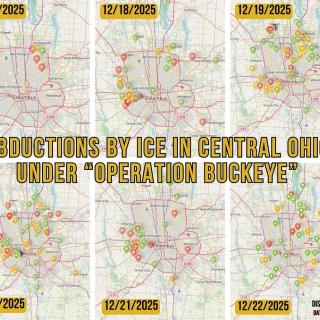On May 8th, a seemingly innocuous document showed up on social media entitled “CSI – BIA – Medical Marijuana (Comments Due 5.25.20).” As an “Active Rule Package” submitted by the Pharmacy Board, it referred to “Executive Order 2011-01K and Senate Bill 2 of the 129th General Assembly, which require state agencies, including the State of Ohio Board of Pharmacy, to draft rules in collaboration with stakeholders, assess and justify an adverse impact on the business community (as defined by S.B. 2), and provide an opportunity for the affected public to provide input on the following rules.” OK, sounds meritorious.
The official sounding doc listed eight sections of the Ohio Administrative code to be amended. It made a few semantic modifications, added legal guardians, deleted THC tiers and revised the notorious “90-day supply.” OK, fair enough.
But the devil, as they say, is in the details. Given no more than cursory mention is Section 3796:8-2-03 (Forms and form variations considered attractive to children) where four little words – “cookie, or other confection” – could change everything.
But first, the uninitiated need to understand edibles. The doc defines an edible as “a product that: (1) Contains marijuana or an extract thereof; (2) Is intended for human consumption by oral administration; and (3) Is presented in the form of foodstuffs.” It is essentially food that is infused with cannabis or its cannabinoids like THC or CBD, which can be extracted from the plant into oils. The oils can then be used with to make cakes, candies, cookies, and other confections. Edibles are so popular that they comprise a rapidly growing, billion-dollar market.
So when the Ohio legislature first fielded a medical marijuana bill, it included edibles as one of several “form[s] in which medical marijuana may be dispensed.” And they have been part of dispensary menus for over a year, as Bloom Medicinals, The Botanist, and Verdant Creations will attest. All seemed quiet on the edible front.
Then came a deeper dive into that dastardly document. A friend pointed out to me that something was awry. Why, she asked, were those four little words added? I was shocked by what I found.
The current rule in OAC section 3796:8-2-03 reads (before):
(B) Pursuant to division (C) of section 3796.06 of the Revised Code, the following medical marijuana products are prohibited as attractive to children:
(2) Any product bearing a reasonable resemblance to a product available for consumption as a commercially available candy;
The suggested change is (after):
(2) Any product bearing a reasonable resemblance to a product available for consumption as a commercially available candy, cookie, or other confection;
Those four little words make this seemingly small change overly broad.
Consider the term “confection.” By definition, it refers to a sweetened food. Confectionery products include baked goods made primarily with sugar, along with candies and chocolates. Websters Dictionary adds a medical twist to its definition: “a medicinal preparation usually made with sugar, syrup, or honey.”
Prohibited appears to have been expanded to ban any – repeat, ANY – medical marijuana product – candy, cookie or otherwise – that contains those sweeteners, deeming such products as “attractive to children.” Essentially, edibles will no longer stock dispensary shelves. Those menus make this clear. As collateral damage, medical cannabis processing companies, which have been slow to come online in the first place, will lose a significant portion of their sales and their investments in the equipment and personnel that produce edibles.
As of May 10th, over 125,000 patients held recommendations; almost 75,000 made purchases totaling $113 million. Using simple math, if just 10% bought edibles, those affected by this rule change would number in the thousands; lost revenue could be millions. The elimination of edibles might well reduce dispensary and processor sales by one quarter or more as the menus indicate. This translates into lost jobs at time when Ohio faces one of the worst economic downturns since the Great Depression.
Further, consumption of cannabis as a food has therapeutic value for many patients as noted by Websters. Chronic pain, as one just example, represents the most common qualifying condition for which Ohio physicians have recommended medical marijuana. Patients report that their use of cannabis in edible form improves management of their pain. And, relief of chronic pain can last longer via edibles than other consumption methods.
One would think that fallout from this substantial change would be detailed in the CSI Active Rule Package. One would be wrong. Information pertaining to CSI’s four goals – facilitate economic growth, transparent and responsive, easy and inexpensive and fair and consistent – became oddly absent from the 3796:8-2-03 section.
Those four little words induce unfairness and inconsistency by eliminating a form of consumption named in the very first version of HB 523 and regularly utilized by patients today. Sick, dying and disabled individuals, likely numbering in the thousands, have come to rely on edibles to treat pain and other debilitating medical conditions.
The factors predicating this change clearly lack transparency. No adverse impacts to patients, the economy or businesses large and small were identified for this revised rule, although several have been covered in this article.
Is the Pharmacy Board saying, stay silent and no one will notice? Dare it be said that the board is trying to eliminate this popular form of cannabis consumption by proxy, using the CSI and children as cover?
The CSI opened a comment period beginning May 8 and ending May 25th (on a holiday). If you’re reading this article on Memorial Day, you still have time to tell the powers that be what you think of this monumental change and the way it was handled. Send an email to both of these addresses: RuleComments@pharmacy.ohio.gov and CSIPublicComments@governor.ohio.gov. See a few pertinent questions below. You can find more information in the Ohio Rights Group’s response here. Otherwise, sound the alarm on social media by sharing this article far and wide.
Edibles are vital to patients. Don’t let government officials steal them away like a thief in the night.
=-=-=
Questions for the Pharmacy Board pertaining to ending edibles:
· Does this article correctly forecast a complete ban on edibles?
· Does this revised rule apply to products already on the market like those listed in dispensary menus?
· Who suggested this new rule and why?
· Have there been specific problems with unauthorized use by children?
· Have there been reports of children breaking into child resistant containers?
· Since the rule would eliminate all edibles, how many processors would go out of business because of this rule change?
· Have the processors who make these products been consulted?
· What portions of processors’ business is derived from edibles?
· What about dispensaries, cultivators and their supply chains? Have their losses been estimated?
· Can you determine the effect on sick patients who lose this form of treatment?
· Have you consulted with doctors about the effect on patients?



